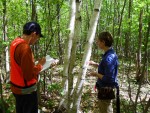This summer, researchers at the Harvard Forest (HFR) Long Term Ecological Research (LTER) program, assisted by scientists from the Center for Tropical Forest Science (CTFS), continued a census of woody stems begun in summer 2010 within a new 35 hectare (over 86 acres) plot at Harvard Forest. This “mega-plot” is part of a global array of large-scale monitoring plots established by Harvard University’s Arnold Arboretum (AA) and CTFS, and recently expanded by the Smithsonian Institution’s Global Earth Observatory (SIGEO) to explore ecosystem processes beyond population dynamics and biodiversity. Given the plot’s location in the shadow of several eddy-flux towers, which measure carbon exchange between forests and the atmosphere, and spanning two watersheds, the resulting data will integrate with and deepen ongoing LTER, NEON (National Ecological Observation Network), and Department of Energy (DOE) studies.
Over the past two growing seasons, using standardized CTFS-SIGEO methodology, HFR Principal Investigator David Orwig and five 2-person crews have measured, tagged, painted, and mapped every stem greater than 1 cm diameter in the plot. The field crews entered quadrat data daily. Vegetation sampling ended in early September 2011. During the 13-week field season in 2011, 43,434 stems were tagged, mapped, and measured, representing approximately 17 ha. Stem densities averaged 2,906 stems per hectare, with a range from 1,756 to 3,193 ha-1. To date, a total of 77,935 stems have been measured in 32 of the 35 ha. About 3 ha of swamp forest remains in the center of the plot and will be sampled this winter once the area is frozen. The HFR plot is dominated by eastern hemlock and northern hardwood species, and will make an excellent comparison with several other hardwood plots in North America and China at similar latitudes.

 Enlarge this image
Enlarge this image